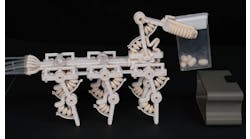A typical manufacturer spends millions of dollars on equipment each year — 10 percent (median) of plant sales — yet many fail to optimize the performance of those investments.
That’s why leading executives focus on incorporating those assets into a Connected Enterprise framework — one that allows them to see how equipment operates in real time (product variance, energy draw, machine reliability, maintenance requirements, etc.) and to proactively address potential problems before they impact production. This leads to production improvements (quality, costs, delivery, safety), longer equipment lifecycles, and improved profitability.
How big is the opportunity in asset management? The machine availability rate for manufacturing plants is 87.5 percent (median) as a percentage of scheduled uptime — a typical operation can’t run machines one out of eight times they’re scheduled. For many manufacturers, the downtime is much worse: 30 percent of plants report machine availability of 75 percent — machines aren’t available one out of four times.
These numbers reflect millions of dollars in lost productivity for plants from equipment failures, which doesn’t include millions more from related excessive energy consumption and/or poor quality when equipment fails and restarts. Those figures show up in overall equipment effectiveness (OEE) — a measure of machine reliability, quality yield, and capacity to produce — which is 80 percent (median) at plants, leaving room for major improvements.
Given these asset-management numbers, it’s not surprising that 10 percent (median) of plant maintenance costs are unplanned. In a Connected Enterprise, however, maintenance becomes proactive as warnings signals from equipment and embedded devices are communicated before machines stop.
Even more valuable is how real-time data can influence operations in real time. In a recent implementation, a cosmetics manufacturer installed the Rockwell Automation FactoryTalk® Metrics software, which generates accurate reporting of real plant-floor activity.
Executives used the software and intelligent devices to monitor, collect, and analyze production data while equipment ran, and were able to dramatically improve OEE and quality of a line previously plagued by downtime. Engineers at this facility now perform PDCA (plan/do/check/adjust) on the fly: they identified problem areas and then configured FactoryTalk to calculate and visualize future OEE for the monitored equipment. When operators receive an alarm, they quickly find the root cause of the stoppage and access the required data for solutions.
The Connected Enterprise also provides information on an enterprise-wide basis that can predict future asset requirements based on energy-consumption, quality trends, maintenance histories, etc. Combining equipment data with demand projections, manufacturing engineers can specify next-generation equipment. For R&D departments, this data allows design engineers to create products that are easier to prototype and manufacture.
The Connected Enterprise offers increased profits now and competitive differentiation tomorrow. Why is your company still stuck in yesterday’s asset-management?


